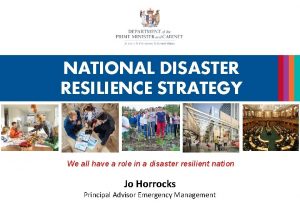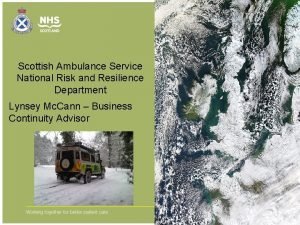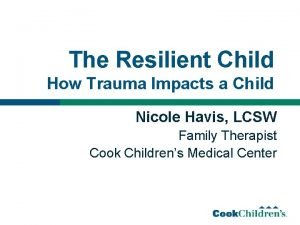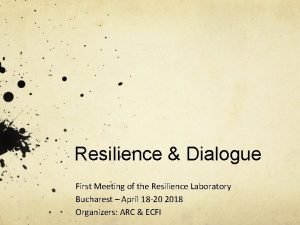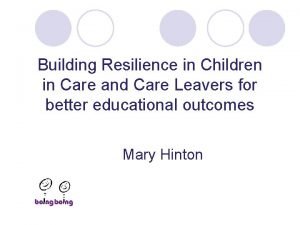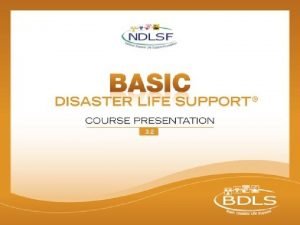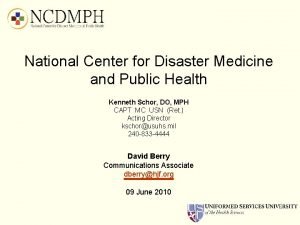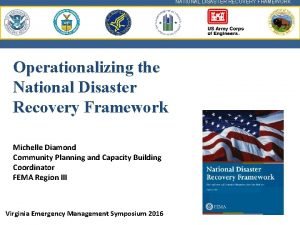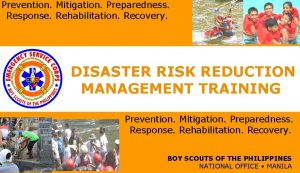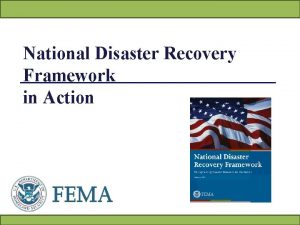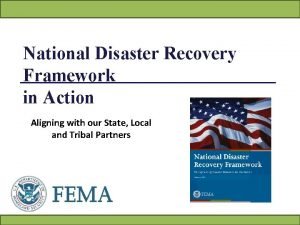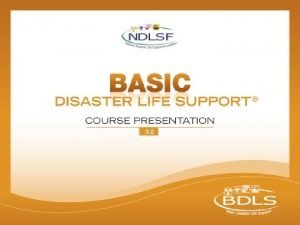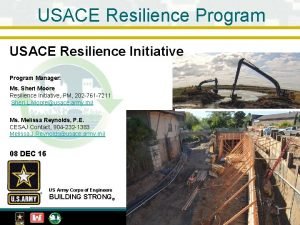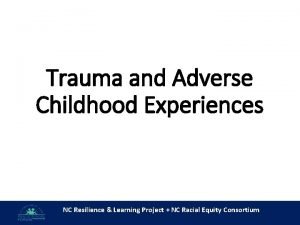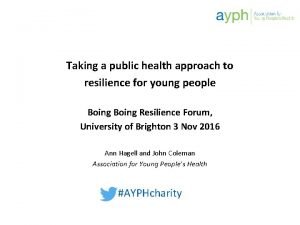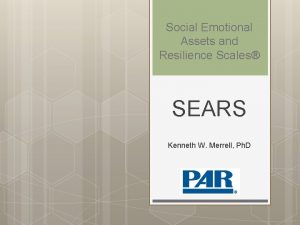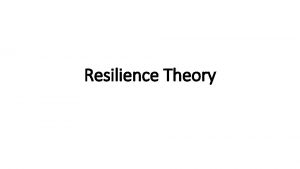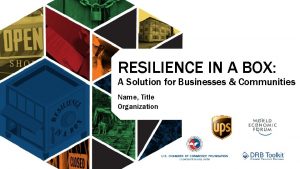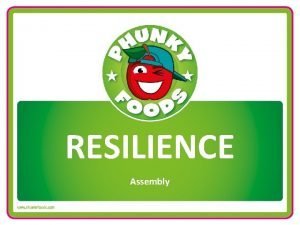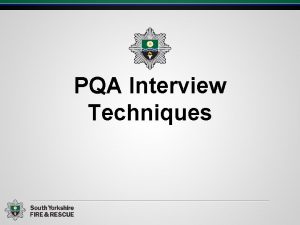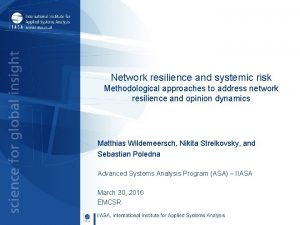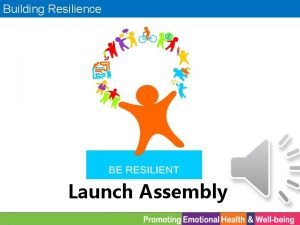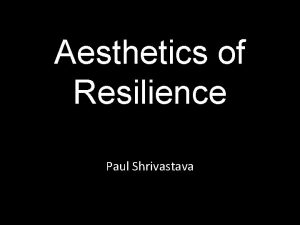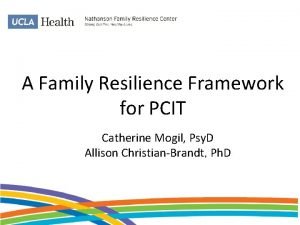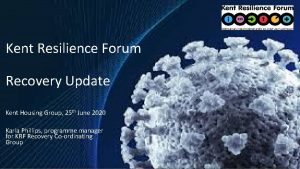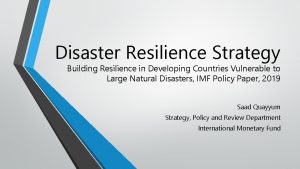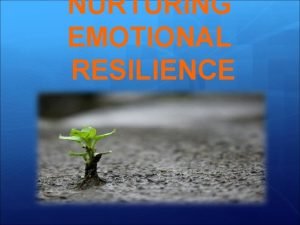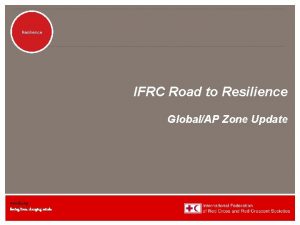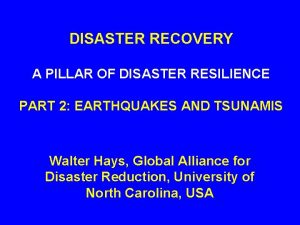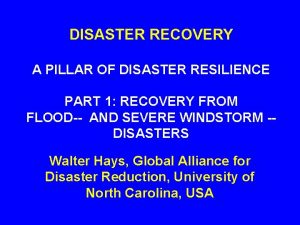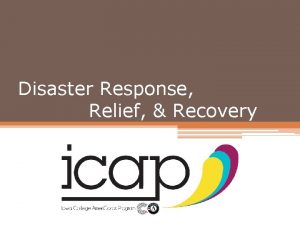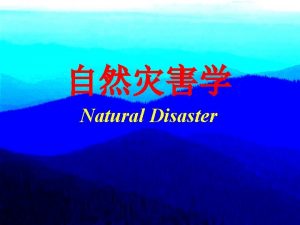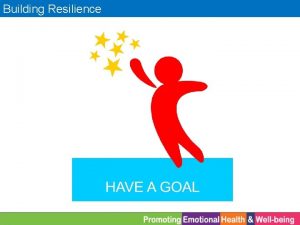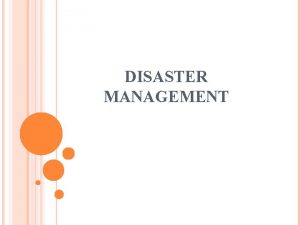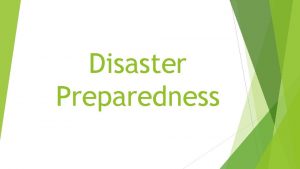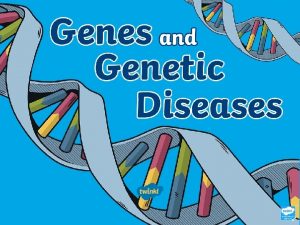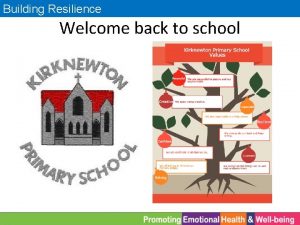NATIONAL DISASTER RESILIENCE STRATEGY We all have a































- Slides: 31

NATIONAL DISASTER RESILIENCE STRATEGY We all have a role in a disaster resilient nation Jo Horrocks Principal Advisor Emergency Management

Why all this resilience talk anyway? ! We face risk Changing risks Increasingly complex and unpredictable risks

The cost of disasters is growing and the portion absorbed by governments and its citizens are even greater. . . USD billions Global economic losses from disasters 1970 -2016 Source: Swiss Re

Adding in the indirect and intangible costs of disasters Tangible costs • Direct tangible costs: costs incurred as a result of the hazard event and have a market value such as damage to private properties and infrastructure • Indirect tangible costs: the flow-on effects that are not directly caused by the natural disaster itself, but arise from the consequences of the damage and destruction such as business and network disruptions • Intangible costs: direct and indirect damages that cannot be easily priced, e. g. : Intangible costs – – – – Loss of life Physical injury and disability Chronic disease Mental health and psychosocial issues Drug and alcohol misuse Crime Family violence Environmental issues

Total economic costs of Black Saturday bushfires, Queensland floods, and Newcastle earthquake – tangible and intangible

The cost of disasters is growing and the portion absorbed by governments and its citizens are even greater. . . USD billions Global economic losses from disasters 1970 -2016 Source: Swiss Re

OUR INCREASING EXPOSURE Our population is increasing, and changing in demographic makeup and diversity We are adding to our built environment – buildings and infrastructure – at a rapid rate We value and depend on an increasingly wide array of products, services, and technology We have fought hard for economic development, growth, prosperity, and wealth

OUR VULNERABILITIES Our population is ageing, has large migrant communities, and deprivation still exists in many areas. Our existing building stock/infrastruct ure is also ageing. Bridges, roads, railways, ports, water supply and the People are living in increasingly marginal locations, particularly around the coast. The budget climate means government and communities must do more with less.

How could our risks change in the long-term? CLIMATE CHANGING POPULATION & SOCIAL GEOGRAPHY TECHNOLOGICAL INNOVATION & DEPENDENCY EFFECTS OF GLOBALISATION UNIVERSAL ACCESS TO INFORMATION GEOPOLITCAL & GOVERNANCE ENVIRONMENT SENSE OF IDENTITY & PLACE

= a complex and changing risk landscape including ‘known-knowns’, ‘known-unknowns’, and ‘unknown-unknowns’

Three important global agreements New Zealand has recently committed to • Sendai Framework for Disaster Risk Reduction At the 3 rd UN World Conference on DRR in March 2015 countries adopted the SFDRR, a 15 year, voluntary, non-binding agreement that aims for the substantial reduction of disaster risk and losses in lives, livelihoods and health and in the economic, physical, social, cultural and environmental assets of persons, businesses, communities and countries. • Sustainable Development Goals In September 2015, countries adopted a set of goals to end poverty, protect the planet, and ensure prosperity for all as part of a new sustainable development agenda. • UNFCCC/Paris Agreement At the Paris climate conference (COP 21) in December 2015, 195 countries adopted the first-ever universal, legally binding global climate agreement. The agreement sets out a global action plan to put the world on track to avoid dangerous climate change by limiting global warming to below 2°C.

What the Sendai Framework promotes • A greater effort to understand risk (in all its dimensions), so that we can prioritise investment, make better riskinformed decisions, and build resilience into everyday processes. • A shift of focus from managing disasters to managing risk, including to reduce the underlying drivers of risk (exposure and vulnerability) • A broader ‘whole-of-society’ approach to risk – everyone has a role in reducing and managing risk.

How the Sendai Framework helps us • Commitment to a disaster risk reduction approach (and reporting requirement) • ‘Best advice’ for how nations should approach disaster risk • Detailed content - goals, priorities, and local/national actions - we can build a strategy around • Benchmark on which we can assess ourselves

Project Timeline PROJECT TIMELINE

Gathering Evidence for a New Strategy Research Relevant capability assessment/review reports Engagement Science, research, guidance and “best practice” Engagement workshops Discussion with key stakeholders and subjectmatter experts

Gathering Evidence for a New Strategy Research Relevant capability assessment/review reports Engagement Science, research, guidance and “best practice” Engagement workshops Discussion with key stakeholders and subjectmatter experts

Gathering Evidence for a New Strategy Research Relevant capability assessment/review reports Engagement Science, research, guidance and “best practice” Engagement workshops Discussion with key stakeholders and subjectmatter experts

Gathering Evidence for a New Strategy Research Relevant capability assessment/review reports Engagement Science, research, guidance and “best practice” Engagement workshops Discussion with key stakeholders and subjectmatter experts

Gathering Evidence for a New Strategy Research Relevant capability assessment/review reports Engagement Science, research, guidance and “best practice” Engagement workshops Discussion with key stakeholders and subjectmatter experts • Joint Committees and Coordinating Executive Groups • Chief Executives and Mayors • Natural Resources Sector/Regional Chief Executives (CEEEFs) • Government departments • National lifelines • Social sector organisations • Risk specialists • Social scientists • ‘Futurists’

DRAFT CONCEPTS APRIL 2017 NATIONAL DISASTER RESILIENCE STRATEGY 1. Concept of national resilience (model) 2. Priorities 3. Focus areas/actions

Draft Concept of National Resilience Social Resilience Economic Resilience of the Built Environment Resilience of the Natural Environment Cultural Capital Governance of Risk and Resilience Social capital Economy Businesses Financial mgt Insurance Resource management Cultural values Health Education Justice/protection Infrastructure Buildings/housing Urban growth/design Leadership Policy Strategy Safety/security Engineering Traditional Land-use planning knowledge/practice Identity Climate change adaptation Culture/heritage Underpinning research, data, and assessment

What makes us resilient to disasters? SUPPORTIVE & ENABLING GOVERNMENT & SOCIETY RESILIENT CITIES/DISTRICTS/REGIONS RESILIENT COMMUNITIES RESILIENT BUSINESSES & ORGANISATIONS RESILIENT HOMES/HOUSEHOLDS

Draft Concept of National Resilience Social Resilience Economic Resilience of the Built Environment Resilience of the Natural Environment Cultural Capital Governance of Risk and Resilience Social capital Economy Businesses Financial mgt Insurance Resource management Cultural values Health Education Justice/protection Infrastructure Buildings/housing Urban growth/design Leadership Policy Strategy Safety/security Engineering Traditional Land-use planning knowledge/practice Identity Climate change adaptation Culture/heritage Underpinning research, data, and assessment

Draft Concept of National Resilience

Draft Priorities Priority 1: Build a culture of resilience Priority 2: Improve the understanding of risk to enable better risk-informed decision-making Priority 3: Priority 4: Reduce existing risk and minimise the creation of new risk Strengthen resilience, both planned and adaptive Findings from Phase 1 and 2 These draft priorities are emerging as the cross-cutting issues that need to be addressed for overall national resilience. They may seem somewhat obvious to those working in this field, but there is no other central document that sets out these things as agreed collective priorities for effort over the long-term. They are not dissimilar to “the 4 Rs”, but with a clear emphasis on risk/resilience as a “by subtraction-by addition” strategy to long-term resilience. They represent a slight re-framing that will hopefully be more palatable to a wider audience (i. e. are not seen as ‘CDEM’).

NATIONAL DISASTER RESILIENCE STRATEGY Priority 1: Build a culture of resilience Focus area #1 Improve the governance of risk and resilience Focus area #2 Integrate resilience principles into everyday processes Focus area #3 Embrace our diversity and build our cultural capital Focus area #4 Being ‘future ready’ Focus area #5 Outreach and education Priority 2: Improve our understanding of risk to enable better risk-informed decision-making Focus area #6 Data collection for disaster risk reduction and resilience Focus area #7 Improve our risk assessment capability Focus area #8 Improve the way we communicate risk for improved risk literacy Focus area #9 Tools and resources to support decisionmaking Priority 3: Reduce existing risk and minimise the creation of new risk Priority 4: Strengthen resilience, both planned and adaptive Focus area #10 Infrastructure protection, upgrading, and resilience Focus area #11 Tackle retreat and relocation Focus area #12 Integrate climate change adaptation with hazard risk management Focus area #13 Encourage resilient development Focus area #14 Risk financing, transfer and insurance Focus area #15 Resilient homes Focus area #16 Business and organisational resilience Focus area #17 Community resilience Focus area #18 City/district resilience Focus Area #19 The resilience role of govt and national organisations Focus area #20 Readiness for response Focus area #21 Readiness for recovery

Focus Area #10: Infrastructure Protection, Upgrading, and Resilience • Resilient infrastructure and infrastructure networks are essential for communities to withstand recover from disasters. Infrastructure provides some of our most basic services that are critical to our quality of life and wellbeing. • However electricity, water, transport, and other infrastructure have some critical vulnerabilities, and the networked nature of infrastructure means that damage in one location can sometimes cause widespread disruption. • In addition to the social impact from the loss of services, infrastructure failure is often the primary source of economic losses from disasters, with costs running into millions of dollars for larger events.

Focus Area #10: Infrastructure Protection, Upgrading, and Resilience • Infrastructure vulnerability can take several forms. • The Canterbury earthquakes highlighted vulnerabilities in the way we build, the land we build on, the fragility of our infrastructure. • While this is daunting, we have great opportunities to modify our built environment over time to be more resilient and, in turn, support improvements in living standards for New Zealanders. • Improvements cannot be instantaneous but if we are smart, even working within existing capital and operational investment cycles, we can make incremental changes that accumulate over time and become significant.

Focus Area #10: Infrastructure Protection, Upgrading, and Resilience Three questions for your consideration… 1. What is your/our desired future in respect of this focus area? – What we should be aiming for in respect of this Focus Area in the 10 -year timeframe – Where do we want to be? What should it look like? What should we be able to do or have in place by 2028? 2. What is your assessment of our current state? – strengths, weaknesses; where there are particular opportunities 3. What needs to happen to get from one to the other? – The generic or specific actions that are needed to progress this Focus Area towards the desired outcome. Actions don’t all need to be done immediately, don’t need to be done by one organisation or sector, can/should be a mix of local, regional, and national, and across any sectors or organisations, as appropriate. – What should your organisation be doing? – What complementary action would you want to see from another organisation or sector, locally or nationally?

Next steps… • March-April ‘ 17 – workshops: – Christchurch (24 March) – Wellington (29 March) – Auckland (6 April) • June ‘ 17– first draft • July-September ‘ 17 – consultation period • October ‘ 17 – final draft • November-December ‘ 17 – to Minister/Cabinet

NATIONAL DISASTER RESILIENCE STRATEGY We all have a role to play in a disaster resilient nation Join the conversation at nationalstrategy@dpmc. govt. nz Or for more information see www. mcdem. govt. nz
 National resilience strategy
National resilience strategy What is a national risk ambulance
What is a national risk ambulance I have resilience
I have resilience I have resilience
I have resilience I have resilience
I have resilience I have resilience
I have resilience Name three line segments
Name three line segments National disaster life support foundation
National disaster life support foundation National center for disaster medicine and public health
National center for disaster medicine and public health National disaster recovery framework 2016
National disaster recovery framework 2016 Republic act 10121
Republic act 10121 National disaster recovery framework
National disaster recovery framework National disaster recovery framework
National disaster recovery framework National disaster life support foundation
National disaster life support foundation What shape has 8 faces
What shape has 8 faces Types of resilience
Types of resilience Nc resilience and learning project
Nc resilience and learning project Boing boing resilience
Boing boing resilience Social emotional assets and resilience scales pdf
Social emotional assets and resilience scales pdf Meaning of resilience
Meaning of resilience Business resilience 101 workbook
Business resilience 101 workbook Resilience assembly
Resilience assembly Firefighter pqas
Firefighter pqas Network resilience a systematic approach
Network resilience a systematic approach Flexibility in dental materials
Flexibility in dental materials Modulus of resilience
Modulus of resilience Assembly on resilience
Assembly on resilience Resilience aesthetic
Resilience aesthetic Nathanson family resilience center
Nathanson family resilience center Emotional resilience in nursing
Emotional resilience in nursing Master resilience training modules
Master resilience training modules Kent test forum
Kent test forum
